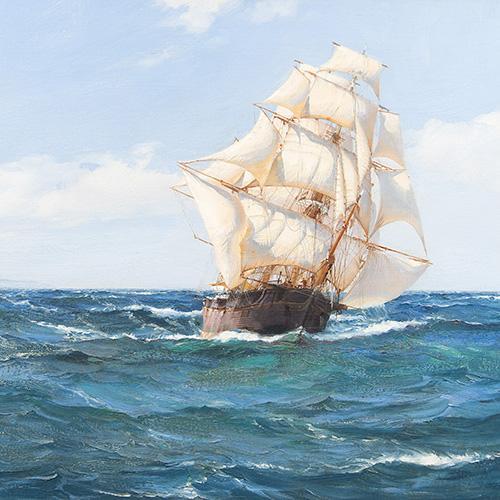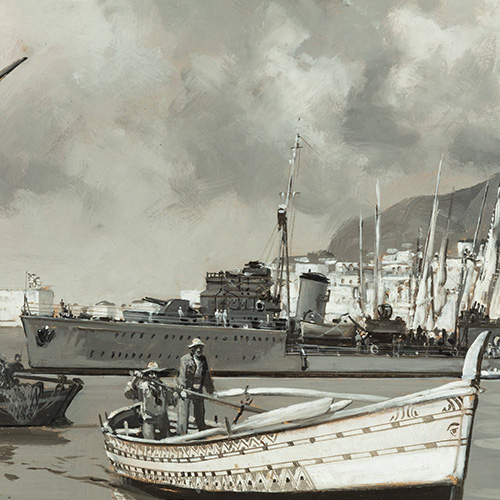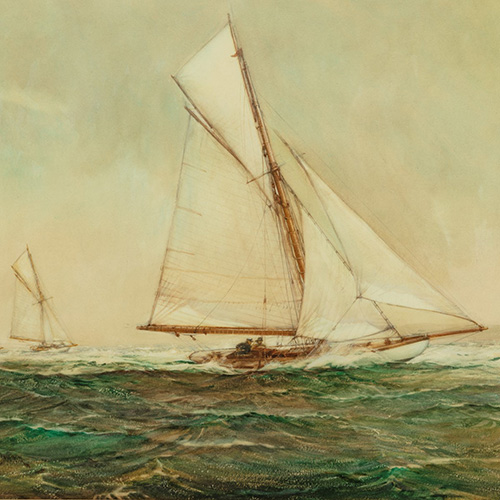

Despite receiving no formal training, Montague Dawson is widely recognised as one of the foremost marine artists of the 20th century. His powerful depictions of frigates and clippers at full sail continue to be collected and cherished the world over.
Dawson was born in Chiswick, London in 1890, the son of Henry Thomas Dawson, an engineer and keen yachtsman, and grandson of Henry Dawson (1811-1878), a maritime painter in whose footsteps he would follow.
Young Montague’s twin passions for painting and all things maritime developed after the family moved to Smugglers House on Southampton Water. A location which provided easy access and unrivalled views of the busy shipping lanes of the Solent.
At age 19, Dawson began working for a commercial art studio in London’s Bedford Row, where he drew and designed posters. Ironically, it was the outbreak of the First World War in 1914 that gave Montague a chance to bring his work to a wider audience.
 Having joined the Royal Navy, Dawson held the rank of Lieutenant, serving predominantly on freighters and minesweepers. He used his time at sea to depict the vessels and events of war at sea, submitting work regularly to the illustrated newspaper, ‘The Sphere’, among other publications of the time. An example of his work at the time is this watercolour of HMS Chrysanthemum at Gibraltar, currently in the Imperial War Museum collection.
Having joined the Royal Navy, Dawson held the rank of Lieutenant, serving predominantly on freighters and minesweepers. He used his time at sea to depict the vessels and events of war at sea, submitting work regularly to the illustrated newspaper, ‘The Sphere’, among other publications of the time. An example of his work at the time is this watercolour of HMS Chrysanthemum at Gibraltar, currently in the Imperial War Museum collection.
During his shore leave, Montague would often make time to visit the celebrated marine artist Charles Napier Hemy RA (1841–1917) at his home in Falmouth. Hemy’s advice and friendship would have a strong influence on the development of Dawson’s own technique. This may have prompted him to submit his first work to the Royal Academy in 1918, entitled “The Eyes of the Fleet”, it depicts a naval ship fighting through raging seas.
Towards the end of the war, Montague was stationed in Leith, a Scottish port to the North of Edinburgh, where his unit specialised in camouflaging ships in the style known as Dazzle Painting. His presence in Scotland meant that Dawson was perfectly situated to capture the surrender of the German Fleet on the Firth of Forth in 1918. Consequently, an entire edition of the ‘The Sphere’ was dedicated to his morale-boosting sketches of the event.
 With the end of hostilities in 1919, Montague decided to focus his efforts on becoming a professional artist, first in London, before later returning to the Hampshire coast at Milford on Sea. It was at this time that he forged a partnership with the London dealers Frost and Reed who would represent the artist throughout his career.
With the end of hostilities in 1919, Montague decided to focus his efforts on becoming a professional artist, first in London, before later returning to the Hampshire coast at Milford on Sea. It was at this time that he forged a partnership with the London dealers Frost and Reed who would represent the artist throughout his career.
Some of his most interesting work from this period came in 1924 while he was still a relatively unknown artist. Dawson agreed to take part in a year long expedition to the South Sea Islands aboard the steam yacht “St George” as official artist of the voyage. In turn he agreed to supply ‘The Graphic’, another weekly illustrated newspaper, with images from the expedition, which served to further enhance his growing reputation.
During this period Dawson increasingly works in oils, rather than the watercolours which dominate his early work, as it allowed him to focus more on details. Similarly, his subjects turn towards ships from the Age of Sail, rather than the contemporary vessels for which his work was synonymous during the war years. This 1926 print of HMS Victory from the collection of Royal Museums Greenwich is a good example of his developing style.
To further enhance the accuracy and drama of his works, Montague would spend as much time as possible on the water, frequently sailing to the North Sea to experience the contrasting conditions triggered by changes of season, weather and wind-speed.
 His unparalleled accuracy of detail both in terms of vessels and environment quickly made Dawson the leading maritime painter of his generation. By the 1930s his collectors included the British Royal Family, and US Presidents Dwight D Eisenhower and Lyndon B Johnson.
His unparalleled accuracy of detail both in terms of vessels and environment quickly made Dawson the leading maritime painter of his generation. By the 1930s his collectors included the British Royal Family, and US Presidents Dwight D Eisenhower and Lyndon B Johnson.
When war in Europe broke out again in 1939, Montague found himself much in demand. Although too advanced in years for active service, the Admiralty were quick to engage his services as a wartime artist. As they had a generation earlier, Dawson’s powerful works would once more bring hope and strength to the British people during dark times.
As we approach the 50th anniversary of his passing in May 1973, Dawson’s works can be seen and admired throughout the world. Arguably the most culturally important works in public hands, his wartime works, are on display at the National Museum of the Royal Navy at Portsmouth Dockyard, Chatham Historic Dockyard in Kent, and the National Maritime Museum, Greenwich.

